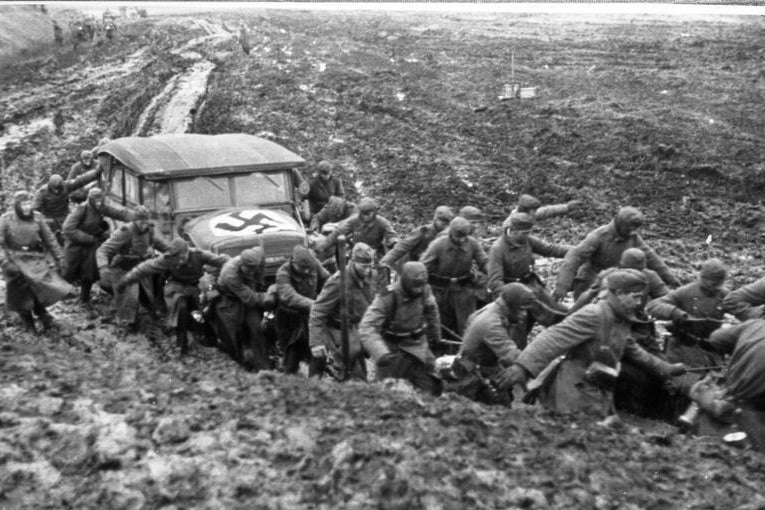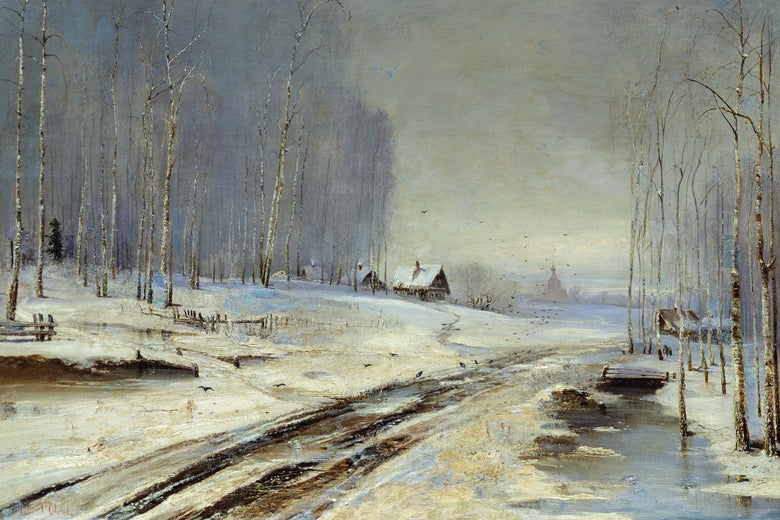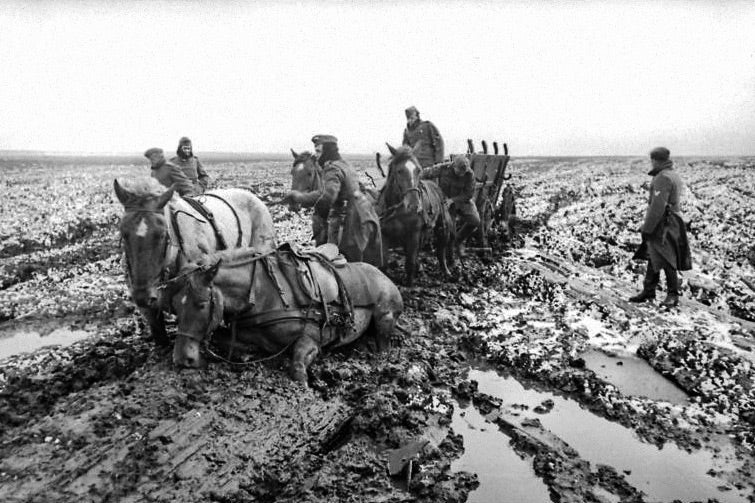“General Mud” Has Usually Been on Russia’s Side in War. Not This Time.
The big thaw is coming for Putin and his army.
Like many, I was surprised by Vladimir Putin’s decision to invade Ukraine, and to not limit his activities to the country’s separatist regions. If Putin’s invasion had been planned for some time, he certainly didn’t choose the best time of year to invade Ukraine. The forecast for the next few days is unusually cold, but in much of the country—as will soon be the case farther north—it is currently the time of rasputitsa or rasputitsia (распутица in Russian).
One Russian dictionary defines rasputitsa as “a time [of year] when dirt roads are difficult to traverse or indeed impossible to do so; the condition of roads at this time [of year].” I have not only spent many a number of springs and falls in Russia but, as someone living on the Canadian prairies, am familiar with the equivalent here. In the spring, melting snow and rain often make dirt roads and fields impassible until they dry out; in the fall, the rains before the snow have the same effect. Strangely enough, the onset of colder temperatures typically makes the going easier, when the ground is frozen—
The timing of Putin’s invasion is particularly odd for someone who seems to place so much stock on historical precedent, given the impact the rasputitsa has had on past foreign invasions of Russia and the Soviet Union. During Napoleon Bonaparte’s invasion of Russia in 1812, the spring rasputitsa was not an issue for the French advance, because Napoleon—in some ways wisely—waited until the summer to launch his invasion. I write “in some ways,” because waiting until the summer does not give armies invading Russia a lot of time before the fall to defeat Russian forces in the vast territory over which they are forced to operate. The fall rasputitsa undoubtedly complicated the initial phases of the retreat of Napoleon’s Grande Armée from Russia, at a time when man and beast struggled in the mud of unpaved roads.
The impact of the rasputitsa is perhaps more celebrated in the case of Nazi Germany’s invasion of the Soviet Union on June 22, 1941. Although the invasion was supposed to have begun in May, a wet spring and the need to send German troops to Yugoslavia in the face of a coup there meant that Operation Barbarossa—the invasion of the Soviet Union—was delayed until late June. Although the dust on the many unpaved roads in the summer caused its own problems, far more detrimental for German mobility was the fall rasputitsa.
By the beginning of October 1941, German forces had not only reached Leningrad and captured Kyiv, but were ready for a last desperate lunge to seize Moscow before the winter. On Oct. 2, 1941, Germany’s Operation Typhoon—and what the Soviet Union called the Moscow Strategic Defensive Operation—began. What is more commonly known as the Battle of Moscow initially went well for German forces. Large numbers of Soviet troops who were blocking the most direct route to Moscow from the eastern side of Smolensk were quickly encircled by German armored forces—a blow to the Red Army, although dealing with the troops caught in the encirclement would be a time-consuming task for the German infantry. Although the Red Army was able to throw some fresh troops in the path of the advancing German army, during mid- to late October, the road to Moscow looked as open as German forces could have reasonably hoped.
That German forces didn’t reach Moscow in late 1941—something that Napoleon managed to do back in 1812—owed much to stubborn Soviet resistance both in front of and behind German lines, as well as logistical difficulties that were hampering the German advance even in the relatively favorable conditions of early fall. Those logistical difficulties would be compounded when the rain came.
Photographs of German vehicles and horses and carts stuck in deep Russian mud are staple fare in books about the German invasion of the Soviet Union. Sometimes horses were mired up to their chests in mud, and both horsedrawn and wheeled vehicles struggled to make any progress, either on- or offroad. Of course, the mud hampered Soviet forces as well, but the Red Army had fallen back on its supply lines, so supplies had much less distance to cover to get to the Red Army forces than to the Germans.
What is perhaps less well publicized than the problems that the mud caused for the German advance is that “General Mud”—as the rasputitsahas sometimes been described in the West—didn’t just help the Soviet Union but has, historically, been something of a free agent. On Aug. 28, 1939, for example, Time magazine published an article entitled “Nationalism and ‘General Mud’ Are on the Polish Side,” in expectation of a foreign invasion of Poland. But in the event, Hitler’s and Stalin’s invasions took place before the rasputitsa could hamper the Soviet forces coming from the east.
Back on the Eastern Front during World War II, having defeated German forces at the gates of Moscow by the beginning of December 1941, the Red Army itself would go onto the offensive with the aim of nothing less than the total defeat of the invaders. A Soviet counteroffensive near Moscow began during the weekend of Dec. 5–7, 1941, and soon snowballed into offensive operations across the whole of the Eastern Front—from Leningrad, on the Baltic Sea, all the way down to Rostov, on the Don River near the Black Sea. Although deep snow hampered this Soviet counteroffensive during the winter months, the death knell for the Soviet offensives was the spring thaw, and the return of the rasputitsa. Much like their German counterparts only months before, by the spring of 1942 Soviet units were at reduced strength, tired, and operating at the end of extended supply lines back to friendly territory. The rasputitsa was in many ways the last nail in the coffin for Soviet offensive operations.
As the war on the Eastern Front progressed, the Red Army got better at conducting offensive operations during seasons that were far from conducive for them. Therasputitsa remained a hindrance, but by 1944, when the last of Soviet territory was liberated, the Red Army had become quite adept at mitigating the problem of the mud. In some parts of the Soviet Union, Red Army forces could lay long corduroy roads made with logs across marsh and swamp, thanks to the wood provided by forested terrain. By 1944, in places where these ad hoc roads could not be built, the Red Army had far more trucks with good cross-country capabilities thanks to the United States. U.S.-supplied Studebakers and other trucks had much better cross-country mobility than the Soviet trucks that were all the Red Army had in 1941.
Today’s Russian army is an army built on experience of what is called, in Russia, the Great Patriotic War—including the experience of keeping an army moving during the rasputitsa. It helps that today, there are far more paved roads across the former Soviet Union—including Ukraine—than there were in early 1942. The current Russian army also has, proportionally, far more all-wheel-drive trucks than its Soviet predecessor had in early 1942 to resupply front-line troops with tanks and tracked or all-wheel-drive armored personnel carriers. That being said, at a certain point the mud can still become a problem for a modern army. It doesn’t take that much traffic to turn a passable-but-wet dirt road into a quagmire, and sticking to paved roads is not an option when the enemy has them well covered with anti-tank and other weapons.
Even today, launching an offensive during the period of rasputitsa is far from ideal. That Vladimir Putin chose to do so suggests his invasion of Ukraine was not as premeditated as some Western observers have chosen to think, that he was overconfident about the likelihood of Russian success, or both. With the Russian army facing much stiffer resistance from Ukrainian forces than expected, the mud is an additional factor that, in some instances, is no doubt slowing the Russian advance down. Though the forecast for Ukraine for the next couple of days is cold, the rasputitsa is, inevitably, coming.
If we are to make parallels between the predicament of Russian troops today and German forces back during the rasputitsa of the fall of 1941, we might not focus on the mud. The most significant similarity is a lack of the necessary logistical preparations for the military operations being carried out. At the beginning of the invasion, Putin’s Russian forces clearly lacked the logistical support for the war they had begun to wage. “General Mud” is, apparently, helping Ukraine now, and may pitch in more in the coming weeks, but his abilities are finite, and he cannot be relied upon to play his part in the longer term.
https://www.blogger.com/blog/post/edit/18389680/3854066062596896524








Geen opmerkingen:
Een reactie posten